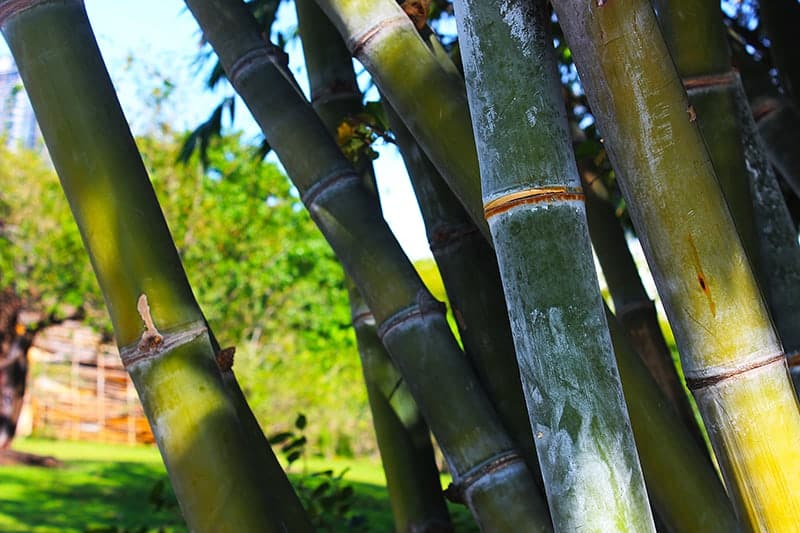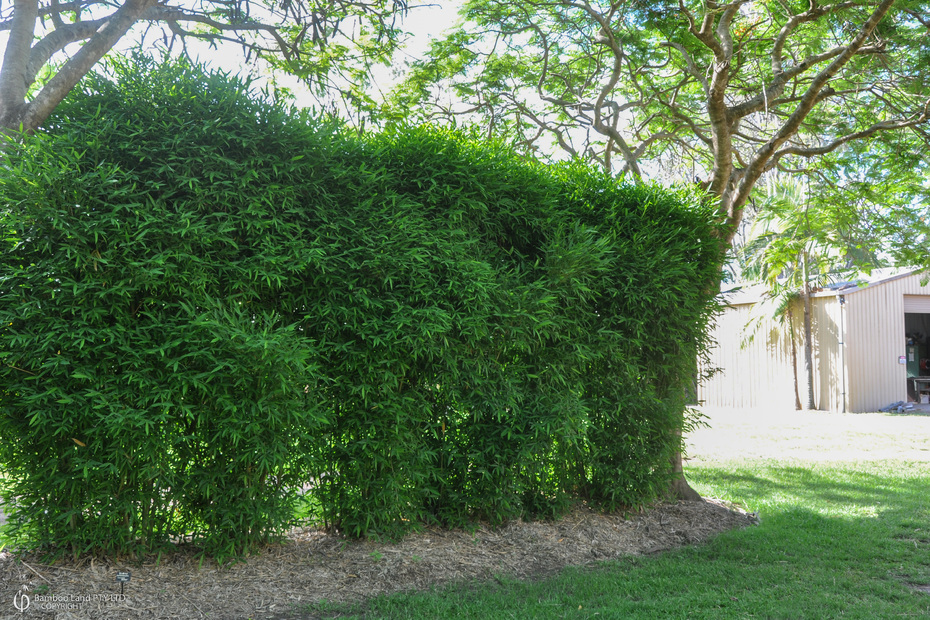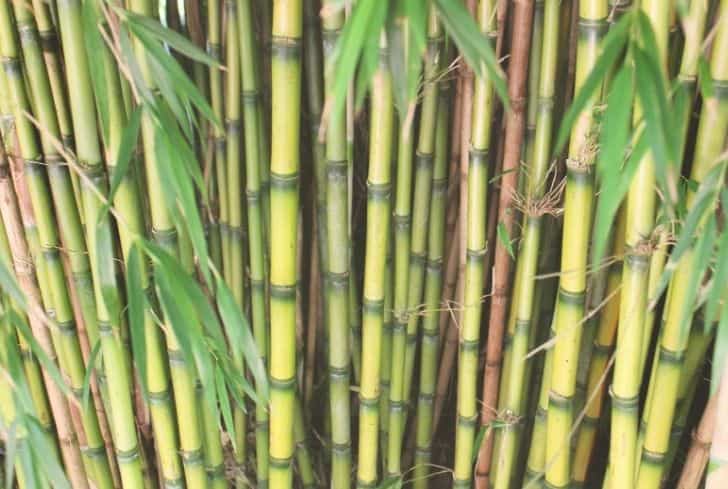If you have a garden that needs an uplift, we have good news for you. Bamboo is ideal for any theme you want, be it contemporary, oriental, or tropical. Then, you have over a dozen types of bamboo to choose from. Some are good for setting up beautiful privacy screens, while others are great for decorative purposes. Read on as we discover which types of bamboo you can plant today.
What is a Bamboo Plant?
The bamboo plant is a member of the grass family, although some types of bamboo grow as tall as trees. Bamboo plants belong to the Poaceae grass family and are woody perennial evergreen plants. Bamboo is the only type of grass that can grow very tall to form a forest if cultivated without pruning.
Bamboo plants are easy to grow and are ideal for warmer climates and slightly acidic soils. According to Science Direct, there are as many as 91 genera of bamboo and over 1000 species around the world. That said, you can find tall bamboo plants, often referred to as bamboo trees, as well as smaller types of bamboo that grow as tall as a few inches.
If you look forward to planting bamboo, there are two main types you need to know. These are the clumping bamboo and running bamboo, which are commonly used in landscaping. The difference between the two is that running bamboo tends to spread horizontally much faster than clumping bamboo and is considered more invasive.
Read on as we discuss the different types of bamboo plants you can plant today, from indoor bamboo plants to taller bamboo plants.
What are the different types of bamboo?
These are the main bamboo varieties you can plant for decoration or as privacy screens.
1. Giant bamboo/Dendrocalamas giganteus

Featured image: Pinterest
If you need a bamboo tree cover for privacy, this is your best type of bamboo. When mature, this bamboo variety grows as tall as 100 feet, and even better, grows as fast as 12 inches every day. It is the tallest bamboo plant and is easy to grow on moist soils. USDA advises a hardiness zone of 9-11 to grow the bamboo.
In appearance, this bamboo plant is tall but sports a chalky white residue over the stems that disappear as the plant ages. When it is fully mature, the once green stems change to dark blue and pale green colors.
2. Umbrella bamboo/Fargesia murielae

Featured image: Pinterest
One of the easiest to maintain bamboo plants is this umbrella bamboo. It does not grow very tall and matures into an umbrella-like shape as the canes bend with foliage weight. It is best used for landscaping purposes as it grows 15 feet tall. It is a clumping bamboo so it won't spread to unwanted areas, and is hardy and adaptable. This bamboo needs moist soil and a hardiness zone of -9.
This type of bamboo has green-yellow canes that also grow slender and narrow green leaves. The foliage has greyish-green undertones, and as the plant matures, it forces the canes to bend. However, you will not need to snap or stalk them, which is why they form the umbrella shape. The bamboo plants grow in clumps as wide as five feet and prefer partial sunlight to maintain the beautiful leaves.
3. Black bamboo/Phyllostachys nigra

Featured image: Pinterest
If you want a colorful privacy screen, you will love what black bamboo has to offer. When you plant the bamboo, it takes on an olive green color that gradually changes to a marble-brown tone, and when fully mature, the stalks appear black. The best thing about black bamboo is that the plants change color at different times, which gives your garden a colorful effect.
The bamboo plant grows as tall as 25 feet, and it prefers partial shades and moist soils to mature. However, the plant can be difficult to maintain in different temperatures, so it is best to follow USDA's recommendation of planting it in a hardiness zone of 7-11.
4. Dwarf Green Stripe Bamboo/Pleioblastus Viridistriatus

Featured image: Pinterest
This bamboo is one of the shortest types of bamboo, growing no taller than three feet tall. Thus, it makes the best ground cover when you have spaces in your garden that need beautiful foliage cover. The plant is identifiable from its yellow leaves with green stripes that look exceptionally beautiful during the summer months.
USDA recommends a hardiness zone of 6a-11 where you also need to grow it under partial shades to preserve the foliage beauty. It is not very fast-growing, and it does well in well-drained moist soils. Before planting it, it could help to remember it is a running bamboo plant that needs constant maintenance.
5. Chinese dwarf bamboo/Bambusa guangxiensis

Featured image: Pinterest
If you need a good bamboo plant for your hedges, the Chinese dwarf is a lush and bushy plant that you can also plant in pots and line up where you want them in your garden. The plant can grow as tall as 10 feet with bright green leaves that pack densely for the best privacy screen. The plant thrives in hardiness zones of 8a-11, in well-drained, moist soils, and under partial sunlight.
6. Japanese arrow bamboo/Pseudosasa japonica

Featured image: Wilsons Bros Gardens
This bamboo plant is a Japanese native that the Japanese Samurai used to make arrows. If you want to plant it in the US, you need to be in hardiness zones of 6 to 10 and plant it in places with partial sunlight or complete shades.
The cold hardy bamboo plant can grow up to 20 feet tall, and it forms a thicket with shiny, palm-like leaves. It is a fast-growing bamboo that can grow four inches taller every day.
7. Painted bamboo/Bambusa vulgaris ‘Vittata’

Featured image: Pinterest
The painted bamboo is a non-invasive bamboo plant that is used for decorative landscaping. It needs moist, well-drained soil to thrive and does very well in hardiness zones between 9-12. In addition, the plant grows as tall as 60 feet in full or partial sun, thus making it an ideal choice for a beautiful privacy screen.
In appearance, this bamboo plant has patterned canes of golden color with green stripes in different areas. It also grows long leaves plus a complex root system that can help you control soil erosion.
8. Japanese timber bamboo/Phyllostachys bambusoides

Featured image: Pinterest
When you need to plant bamboo for timber, this evergreen bamboo plant will not disappoint. It is referred to as the Japanese timber bamboo because it is widely farmed for timber in native Japan. To grow it, you need to be in a hardiness zone of 7-10 and use fertile, well-drained, and moist soil under the full sun or slightly partial shades.
Growing up to 70 feet tall, it is one of the tallest different types of bamboo plants. In appearance, the plant sports smooth and glossy emerald green canes that gradually change color to yellow-green undertones as they mature. The large leaves also sport a bright green surface and are dull green underneath. While it is a good solution for a privacy screen or living fence, the plant can also get out of control in ideal conditions.
9. Chilean bamboo/Chusquea culeou

Featured image: Pinterest
If you need bamboo for the most temperate climates, this Chilean bamboo is an ornamental plant that can make a difference in your garden. It is a native of South America that grows in clumps and is credited for controlling different dynamics ot forestry, mostly by impeding regeneration or fragile trees.
In appearance, this bamboo sports long yellow-lime green canes with dark blue-green nodes plus beautiful green leaves. The plant needs direct sunlight to thrive. You can grow it on moist soils and cooler climates not lower than 0-degrees.
10. Moso bamboo/Phyllostachys edulis

Featured image: Pinterest
The Moso bamboo is a hardy plant that grows as tall as 60 feet. In its native East Asian regions, it is widely grown for paper production as it grows with thick and robust straight canes. While it looks majestic, the leaves are considerably small but still make a beautiful addition to your privacy screen.
The plant sports dark green canes at a young age, but these eventually turn to an orange-yellow undertone when mature. The canes are also covered in velvety hair, and the bamboo is ideal for hardiness zones between 7-10. It grows on moist soils and under the full sun or a partial shade.
11. Buddha belly bamboo

Featured image: Pinterest
This ornamental bamboo is named so for its resemblance to the belly of the Buddha. It is mostly ideal for growing in pots or container gardens in fertile, well-drained, and moist soils. Ensure you live in a hardiness area between 9-12 and you have a spot that receives full sunlight and a partial shade when it gets too hot.
How Do You Grow Bamboo?
When you have found the best type of bamboo for your garden, the process of planting the plant is fairly easy. But first, you need to consider what bamboo you are planting;
- Running bamboo sends its rhizomes horizontally, which can make it a very invasive plant
- Clumping bamboo will not spread, but rather, it grows in tight clusters where you plant it
In addition to the type, you will also need to consider the climate you live in. Most bamboo species thrive in tropical climates, but hardy bamboo will do well in colder climates. But, when planting, it is better to start the process during the warmer spring season. With this in mind, here are the steps to plant your bamboo plants.
- Soak your seeds. If you are planting bamboo seeds, you will need to soak them for 6-12 hours after they are dried in the sun. Only drain this water up to half an hour before planting them.
- Pick an ideal spot. Depending on the type of bamboo trees you want to plant, you will need to pick a spot in your yard that receives a good amount of direct sun daily and is shaded during the hotter hour of the day. The spot is also important in the winter months since a shaded area will provide frost protection, thus not dehydrating the bamboo. In addition, make sure the spot does not receive very strong winds that could damage the tall bamboo trees since the roots are not very strong.
- Amend the soil. Most bamboo plants will only thrive in fertile soils, making it vital to dig the spot and mix the soil with vital nutrients before planting the plant. Make sure to add your compost and nutrients at the bottom of the hole, and avoid using soil types that don't drain easily.
- Put up barriers to prevent running. If you are planting running bamboo, your best solution to prevent the plant from invading neighboring areas is to install deep barriers that run up to four feet beneath the surface.
- Plant the bamboo. If you are starting with seeds, it is better first to plant them in a plastic pallet. In this case, transfer the amended soil into the plastic and plant the seed. Plant one seed in each pallet, making sure to plant it about two inches deep in the middle of the pallet. Transplant them into pre-dug holes after 3-4 months.
- If you have ready seedlings, it is better to transfer them into the dug holes with amended soil. For this step, make sure to space the seedlings about 3 to 5 feet apart to create a beautiful privacy screen early on.
- Water them. Once you have panted the seeds or seedlings, moisten the soil immediately and daily for better results.
How to Care for Bamboo Plants
Once your best bamboo plants are in the soil, it is best to provide consistent care to them as follows;
- Water the soil daily. You need to ensure the soil is always moist but draining for the first few weeks, but you can scale the watering back once the plants gain strength. Please note, you don't have to water the plants daily if it is raining.
- Feed the bamboo plants. You can start feeding the bamboo plant a month after planting. You can add bamboo-specific fertilizer or add a layer of rich compost around the base. The compost will also help the plant to stay strong during the winter months.
- Protect the young plants from winter. If you notice your bamboo plant looking dry, it could be because of the extremely cold temperatures. You may need to prevent its dying by constructing a temporary barrier around it.
- In early fall or late summer, you will need to prune and thin the bamboo plants. You can trim the top to control the plant's height or cut branch nodes to thin the plant. If the bamboo clusters are too thick, you can dig a part of the ball root and plant it separately.
- Pest and disease control. Even as the plant is very sturdy, you need to protect it from pests such as bamboo mites with an insecticide. Also, you can use a plant fungicide to rid the plant of fungal diseases. On the other hand, you will need to dig up the plant and discard it if it gets infected with the mosaic virus or root and heart rots.
